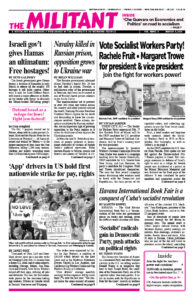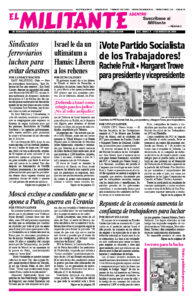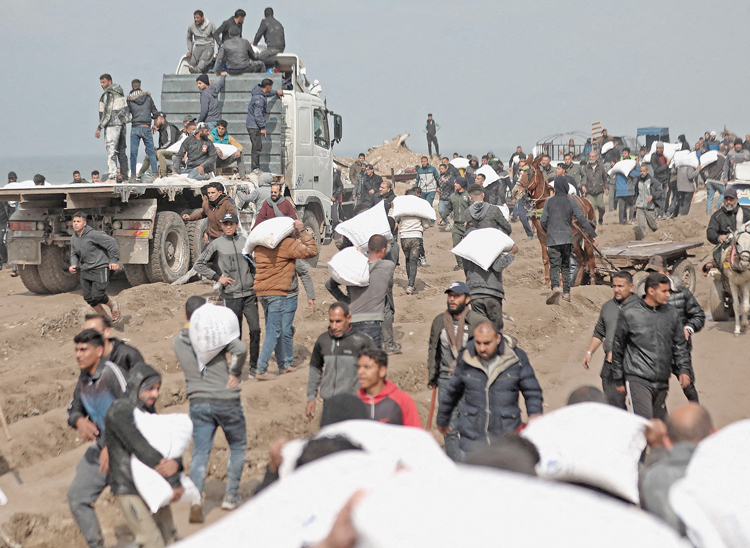The Israeli government gave Hamas leaders a deadline of Ramadan in early March to release all the roughly 100 hostages it still holds captive. Otherwise, it said, the Israel Defense Forces will launch a major offensive on Rafah, on the border with Egypt, to eliminate the Tehran-backed Jew-hating group’s last Gaza stronghold.
The Oct. 7 pogrom carried out by Hamas, along with its junior partners Islamic Jihad and the Popular Front for the Liberation of Palestine — all financed, armed and trained by Tehran — is the largest massacre of Jews since the Nazi Holocaust, killing 1,200 men, women, children and elderly, wounding more than 5,000 and taking over 240 hostages.
Israel’s success since then in demolishing Hamas’ bases and structure in Gaza has opened more space for Palestinians to speak out — even if still modestly. They’re protesting against the reactionary group for using civilians as human shields by locating their bases, living quarters, arms caches and prison cells under hospitals, mosques, apartment buildings and schools.
Ihab Hassan, a Palestinian from the West Bank who now lives in Washington, D.C., posted a video Feb. 15 showing a night-time protest in Rafah, demanding that Yahya Sinwar, Hamas’ central military commander in Gaza, resign. “The people demand a cease-fire again,” they chanted. They were referring to the cease-fire with Israel that was in place until Hamas broke it to launch its Oct. 7 pogrom.
On Feb. 16, relatives of Muhammad al-Araja, a teenager shot dead by Hamas police when he tried to take aid packages from a U.N. truck, burned tires in protest near the Egyptian-Gaza border crossing, Yedioth Aronoth reported.
It’s no secret that Hamas leaders steal a significant portion of aid intended for civilians to give to its combatants or to sell to enrich themselves.
Gazans hold Hamas responsible
A statement issued by families and clans of Rafah Governorate said that Muhammed al-Araja was “martyred by the bullets of treachery and betrayal by militias affiliated with Hamas.”
The result of Oct. 7 has been “the occupation of land, the killing of people and the absence of justice,” the statement says. “We the families and clans of Rafah Governorate, hold Hamas responsible.”
Tehran and Hamas apparently picked Oct. 7 for the slaughter — which they had been planning for years — believing Israel was vulnerable after months of acrimonious disputes over a judicial reform proposed by Prime Minister Benyamin Netanyahu. Tehran also hoped the assault would provoke an Israeli response that would lead to reversal of the trend of Arab governments establishing normalized diplomatic and economic relations with Israel.
They also expected the Israeli response would be relatively brief, like after previous Hamas terror attacks. They thought that by taking as many hostages as possible, they would force Israel to release thousands of Hamas prisoners in Israeli jails and then sign another cease-fire. On all scores the Tehran-led “axis of resistance” badly miscalculated.
The Hamas-led rampage included the rape and mutilation of many of its victims, the murder of entire families, and the killing or taking hostage of anyone friendly to Jews, including Arab, Thai, Nepalese, Filipino and African workers. The Israeli government, backed by most Israelis, had no choice but to fight to eliminate Hamas once and for all.
Hamas keeps hiding in hospitals
Hamas apologists, including liberal bourgeois papers like the Washington Post, have raised a hue and a cry about Israeli forces encircling Nasser Hospital in Khan Younis, echoing slanders that Israel deliberately targets civilians. The head of the U.N.’s World Heath Organization claimed that the hospital is “not functional anymore.”
In fact, in a targeted operation Feb. 15, Israeli soldiers in the hospital captured Hamas combatants posing as medical staff, and found weapons, a vehicle used in the Oct. 7 massacre, and a vehicle stolen from Kibbutz Nir Oz, one of the communities assaulted that day.
At the same time, Israel Defense Forces provided the hospital with food, water, oxygen tanks, fuel for electricity and a replacement generator.
The Hamas-run Gaza Health Ministry claims almost 30,000 people have been killed there since the start of the war. On Feb. 19 Hamas admitted that at least 6,000 of the dead are its combatants. Israeli army officials estimate that the real number is twice that.
Proof continues to come out on the complicity of U.N. staff with Hamas. Israeli authorities released a video Feb. 16 showing a U.N. Relief and Works Agency employee participating in the pogrom at Kibbutz Beeri Oct. 7, helping Hamas thugs load the body of an Israeli man into a car and driving off with it.
Meanwhile, the Joseph Biden administration, while claiming it’s a friend of Israel and the Jews, has stepped up demands that Israel wind down the offensive against Hamas, agree to a cease-fire and accept a “two-state” solution. On Feb. 19 the U.S. government proposed a resolution to the U.N. Security Council calling for a temporary cease-fire and opposing an Israeli offensive in Rafah.
Arab regimes in Egypt, Jordan, Bahrain and the United Arab Emirates, which have diplomatic and trade relations with Israel, and in Saudi Arabia, have joined the call for a cease-fire, blaming Israel for civilian deaths in its war against Hamas.
But whatever they say in public, it’s clear they don’t want the reactionary bourgeois clerical regime in Tehran to advance its destabilizing influence in the region.
Egyptian officials have warned Hamas to reach a deal with Israel, and have been strengthening the wall that separates Gaza from Egypt and sending tanks to the border to prevent Hamas combatants from crossing it.


